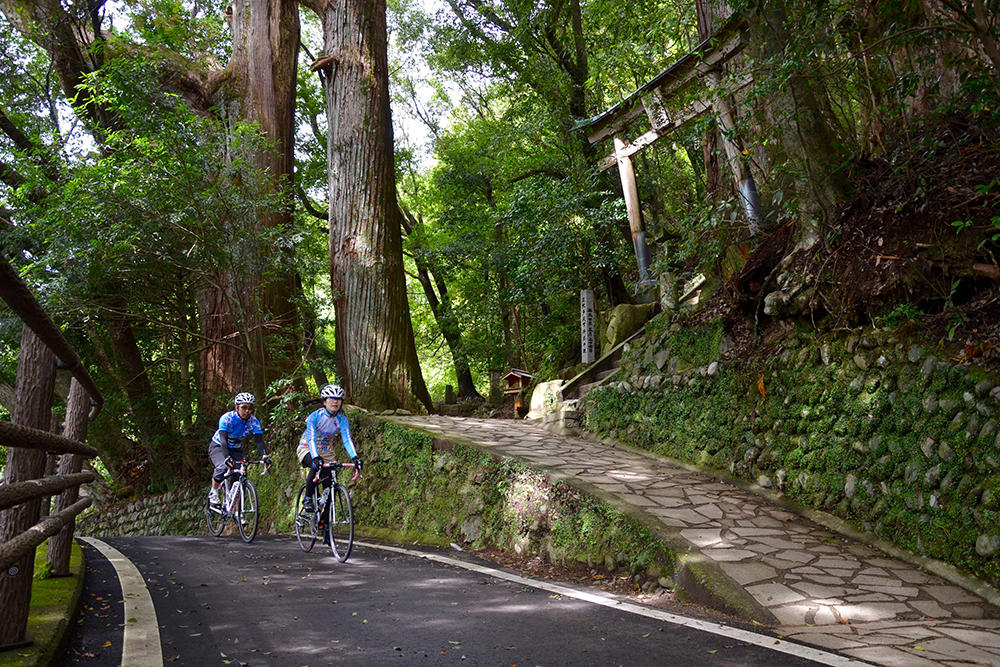
This cycle route is long and you cross over a mountain ridge to the World Heritage site of Kumano Kodo, then you ride over to “Kumano Sanzan” (the three grand shrines) which are Kumano Hongu Taisha, Kumano Hayatama Taisha and Kumano Nachi Taisha.
If you ride on a bike, you can feel the joys of nature from Kumano. Kumano is the origin and training place of the “Shugendo” (Japanese mountain asceticism incorporating Shinto and Buddhist concepts) and you can experience this ancient religion and pilgrimage to Kumano shrines yourself.
A leisurely ride while stopping for two days and staying over one night is our recommendation.
One of the great pleasures of this route is to visit shrines and see great sights including going up and down moss covered stone steps.
For your ride, bring an extra pair of shoes or choose walkable and grippy shoes such as flat pedal shoes or shoes for specifically for mountain bike pedals.
After you leave Nanki Shirahama, go down one of the side streets, where you can feel the history and atmosphere of the area, by following the Nakahechi Route in Kumano Kodo and avoid the busy traffic-filled National Route 311. There is also a paved Kumano Kodo road around Tsugizakura Oji and Chikatsuyu Oji where you can ride.
Accommodation on the first day after you finish riding the boundless expanse of Nakahechi is Kawayu Onsen (Hot Springs). Its hot water comes from the riverside and it is located just before Kumano Hongu Taisha (one of the 3 grand shrines of Kumano).
On the second day, leave Kawayu Onsen to go to Kumano Hongu Taisha through the oldest hot springs in Japan called “Yunomine Onsen”.
Then go to Kumano Hayatama Taisha (another one of the 3 grand shrines of Kumano), heading down the Kumano river. Just before this however, Kamikura Shrine, which is famous for its heavy slope stone steps and large rock of Goshintai (body of God) is worth seeing.
Cycle along the beach by the Kumano Sea and then ride in the direction of Kumano Nachi Taisha (the third grand shrine of Kumano) by entering the road along the Nachi River.
After you park your bicycle around the Daimonzaka parking area, we recommend you to climb Daimonzaka on foot and then visit Kumano Nachi Taisha and Nachi Falls. Once you are done, go back to the Daimonzaka parking area by taking a bus from the nearby Nachi Falls bus stop.
After you visit Nachi, go down the slope and the endpoint is JR Kii-Katsuura Station.
It is a convenient to go back in the direction of Shirahama or Wakayama by Rinko Style (using a bicycle bag to bring your bike onto the train) as the limited express train (Kuroshio) stops at this station.
Cyclists are of course welcome to stay at hotels overnight around Katsuura Town (on the coast of the southeast part of Wakayama Prefecture) and get a great taste of the finest maguro (tuna) from the Katsuura fishing port.
Distance: 135km, Elevation Gain: 2,660m

You can cycle through side roads along the Tonda river on the Nakahechi route in Kumano Kodo. Then go over the elegant suspension bridge, which uses wooden slats.
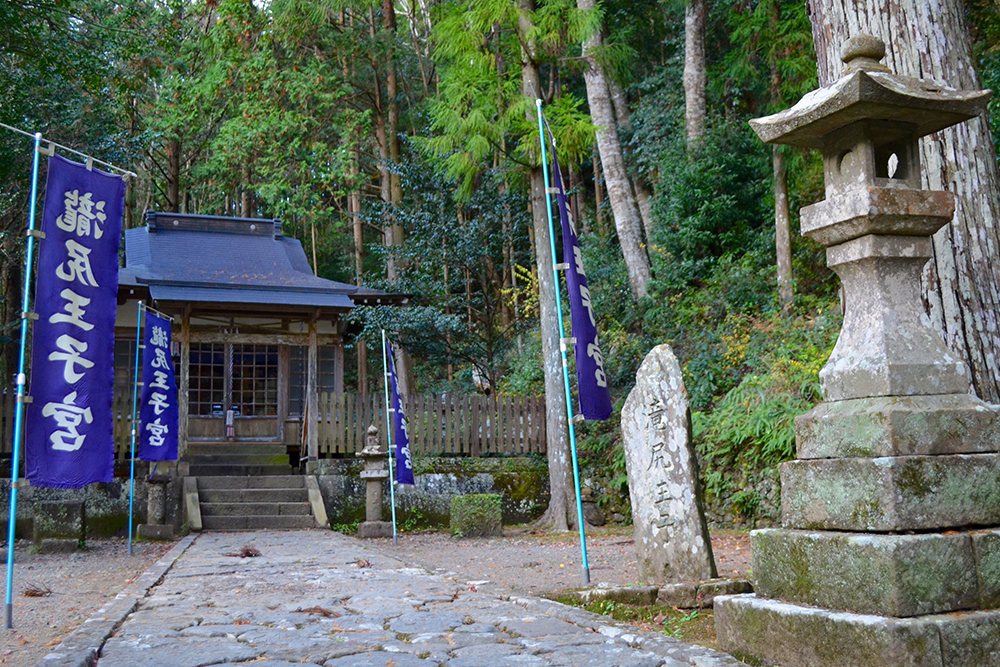
After you pass the “Takijiri Oji”, the spiritual entrance to the sacred Kumano Mountains (the entrance of the ancient pilgrimage to the three grand shrines of Kumano), the full hill climb starts.
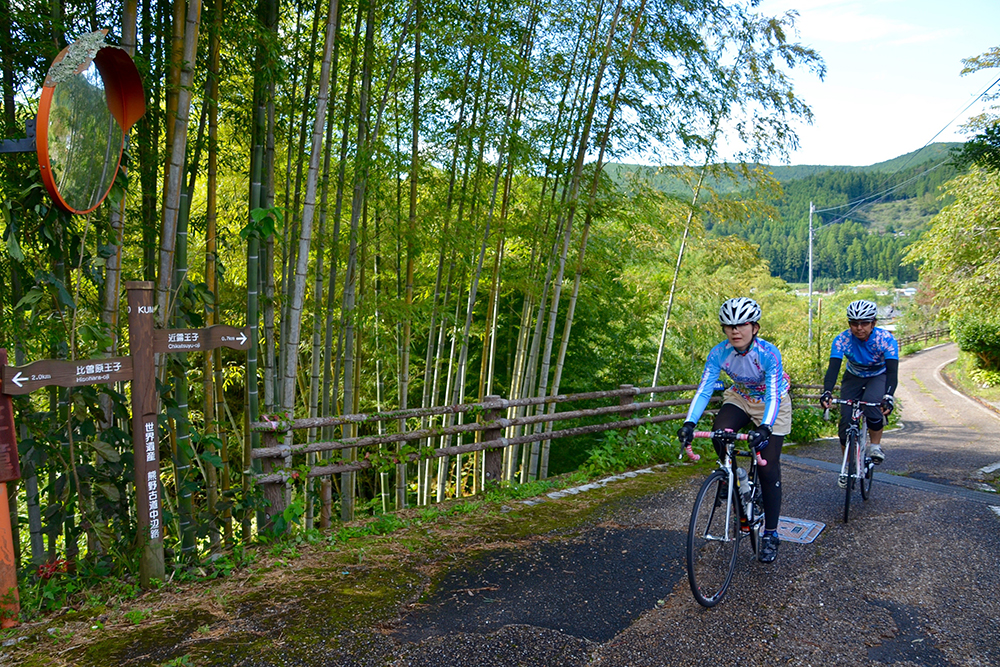
After you pass “Chikatsuyu Oji”, keep your eyes open for a small sign of “Kumano Kodo”. Then enter the paved, but narrow road called Kumano Kodo Nakahechi.

After you leave the main road and enter Kumano Kodo, the atmosphere will drastically change. Enjoy cycling while you feel the sanctuary of nature which is the origin of Kumano religion.
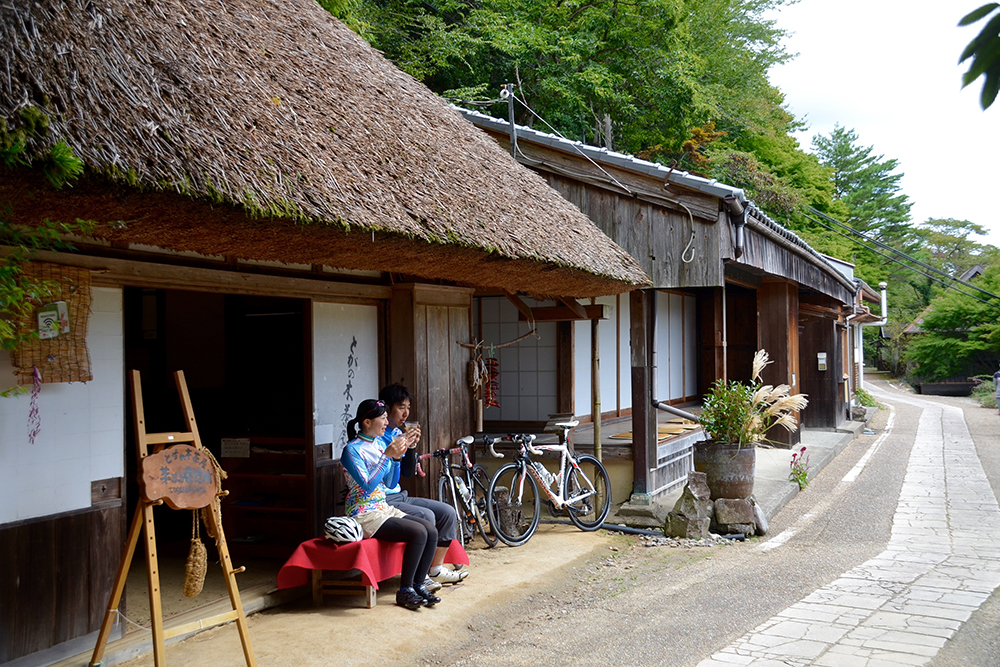
A small cabin with a thatched roof called “Toganoki Chaya” next to “Tsugizakura Oji” (an ancient shrine with trees that are centuries old), is a warm atmospheric rest house organized by local volunteers.
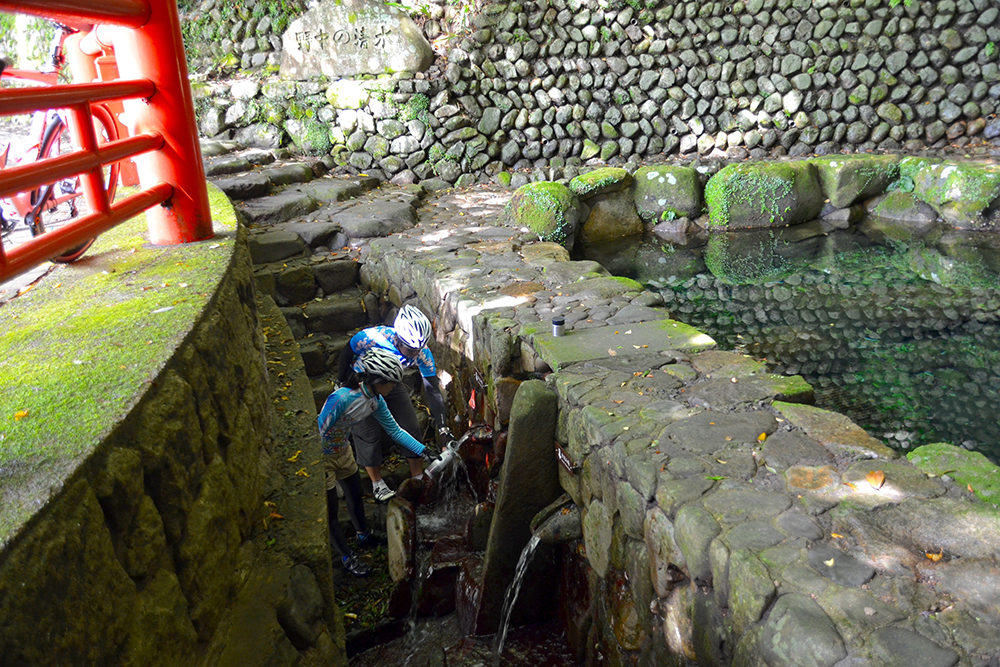
When you go down the stairs in front of Toganoki Chaya, there will be “Nonaka no Shimizu” (Nonaka Pure Natural Water).
After you fill a bottle with this water, which is treated with reverence by local people, its time to start cycling again.

Kawayu Onsen is a unique hot spring, as the hot water gushes out from the riverbed.
Fujiya ryokan (a traditional Japanese-style hotel) welcomes cyclists and is a good way to enjoy this route over a two day period if you desire to stay overnight.

“Yunomine Onsen”, the oldest hot springs in Japan, is lined with elegant and beautiful onsen (hot spring) hotels along the river. “Tsubo-Yu” (natural rock hot springs) is the only onsen to have been registered as the World Heritage site.
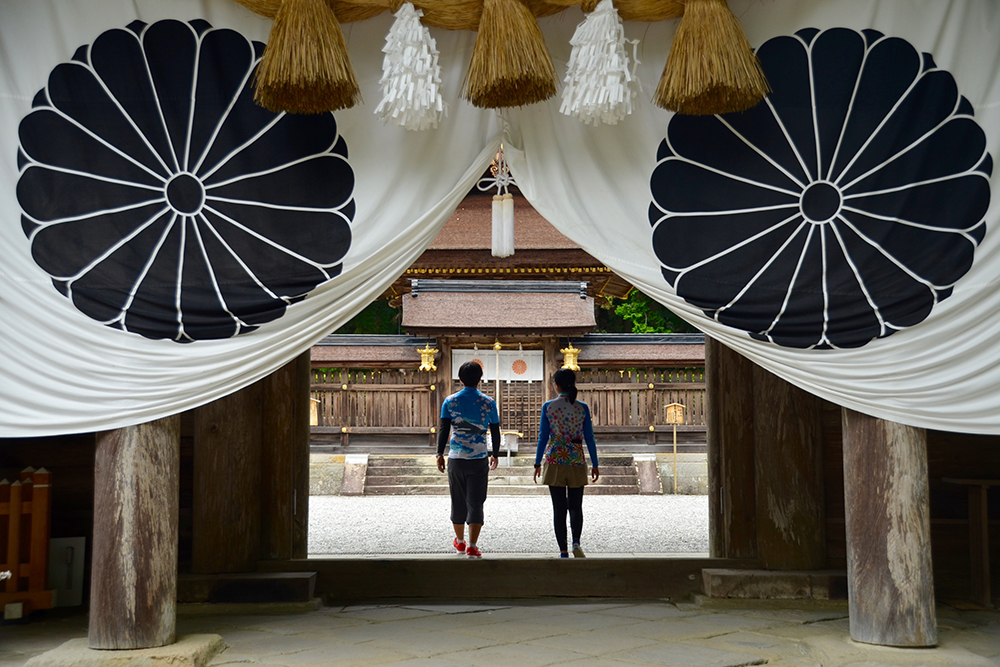
Kumano Hongu Taisha has a elegant appearance with a commanding atmosphere.
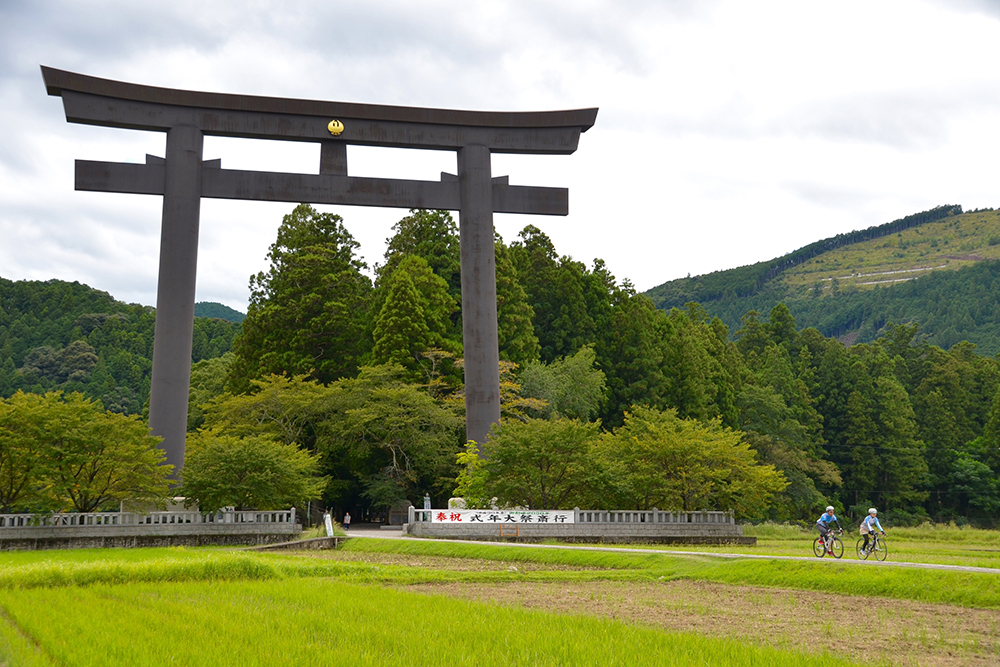
This Oodorii at “Ooyunohara” is the tallest guard frame of Shinto shrine in Japan. “Ooyunohara” was the place for Kumano Hongu Taisha Shrine before a flood during the Meiji period.

Before you go to Kumano Hayatama Taisha, visit “Kamikura Shrine” which is famous for heavy sloping stone steps and big rock of Goshintai (body of God). The view from a “Hokora” (a small shrine) enshrining the massive rock is splendid, but the stone steps are really steep. It is dangerous to walk this stone steps with cleat shoes.
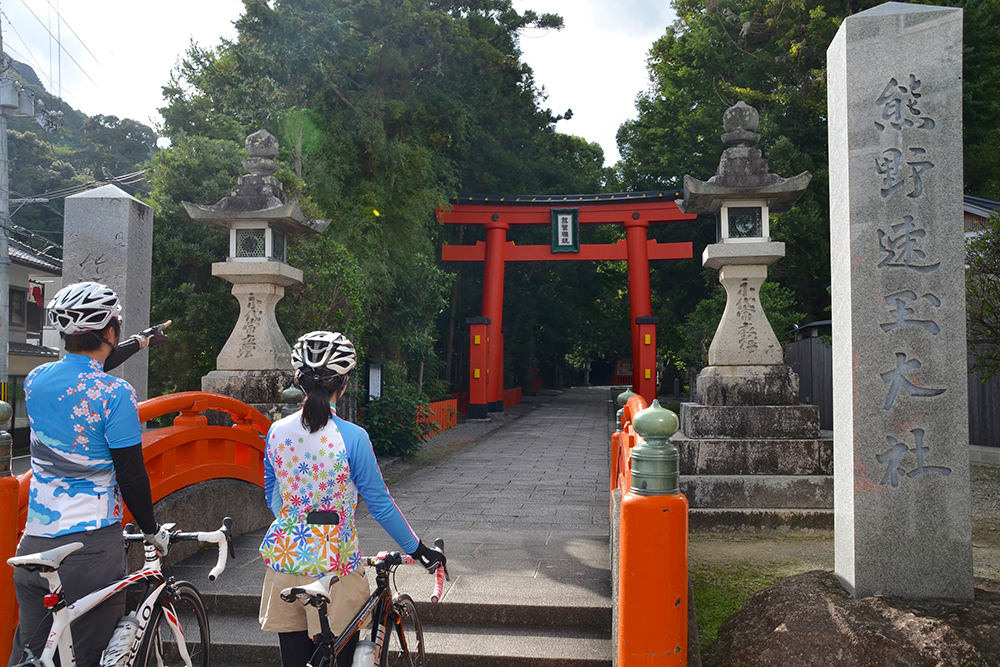
Kumano Hayatama Taisha is comparatively located closer to the city compared with the other two grand shrines of Kumano and it has a brilliant, colorful atmosphere.

It’s time to discuss sweets in Shingu City, “Suzuyaki” of Kobaido (a local Japanese pâtisserie) is very famous. It is only 400m away from Kumano Hayatama Taisha. Suzuyaki are bell-shaped, fluffy and fine “kasutera” (sponge cakes), which are light, not overly sweet and have fragrant smell which makes you unable to stop eating them.
One bag of 20 Suzuyaki will be good for you, whilst you ride your bicycle.

When you go to Kumano Nachi Taisha, we recommend you to park your bicycle around the Daimonzaka parking area and climb Daimonzaka on foot. Then you can visit Kumano Nachi Taisha and Nachi Falls smoothly. Once you are done, go back to the Daimonzaka parking area by taking a bus from the nearby Nachi Falls bus stop.
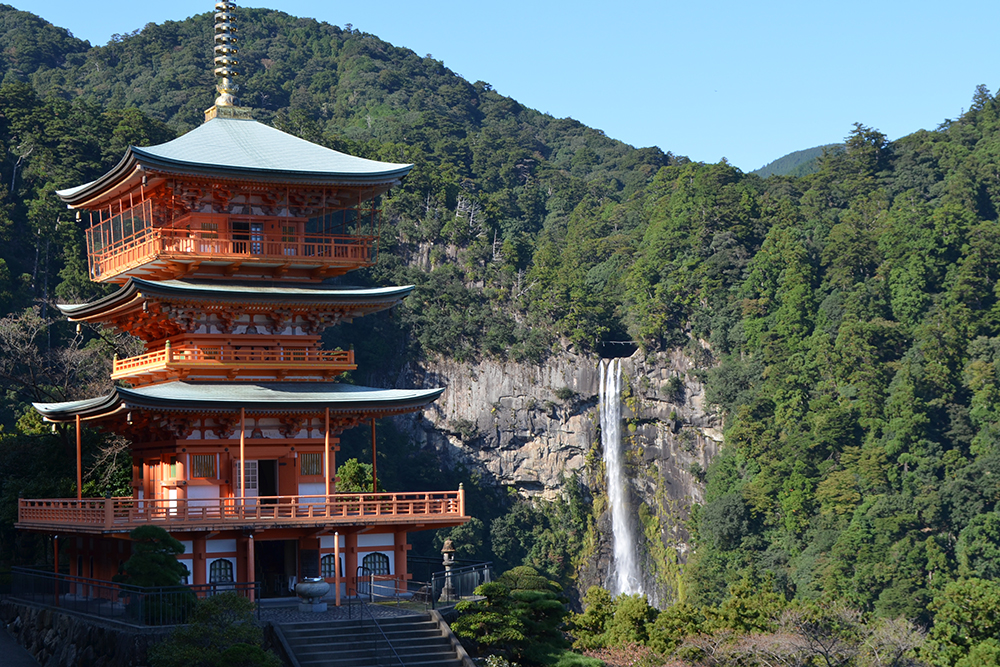
The final destination of the Kumano Sanzan Trip is “Nachi Falls”, one of the best-known waterfalls in Japan with a drop of 133m, next to Kumano Nachi Taisha.
To get there, climb a flight of stone steps from the final point of Daimonzaka, then descend down a slope through the shrines which are built among the mountain range. Then go to Nachi Falls, which is worshiped in nature as a holy ground and origin of the land.
